In recent years, innovative farmers and gardeners have been finding creative ways to grow food sustainably—even in limited spaces. Among these inventive methods, combining aquariums with greenhouses has become an exciting approach to producing healthy, organic, and water-efficient crops.
This technique allows you to grow aquatic vegetables—like water spinach, lettuce, and even some herbs—by using fish waste as a natural fertilizer. The system is clean, eco-friendly, and surprisingly simple to set up at home.
In this article, we’ll explore how a farmer successfully built a DIY aquarium and greenhouse system to grow aquatic vegetables. You’ll learn how it works, the materials you’ll need, and how you can build your own system to enjoy fresh, homegrown produce year-round.
The Concept: Merging an Aquarium with a Greenhouse
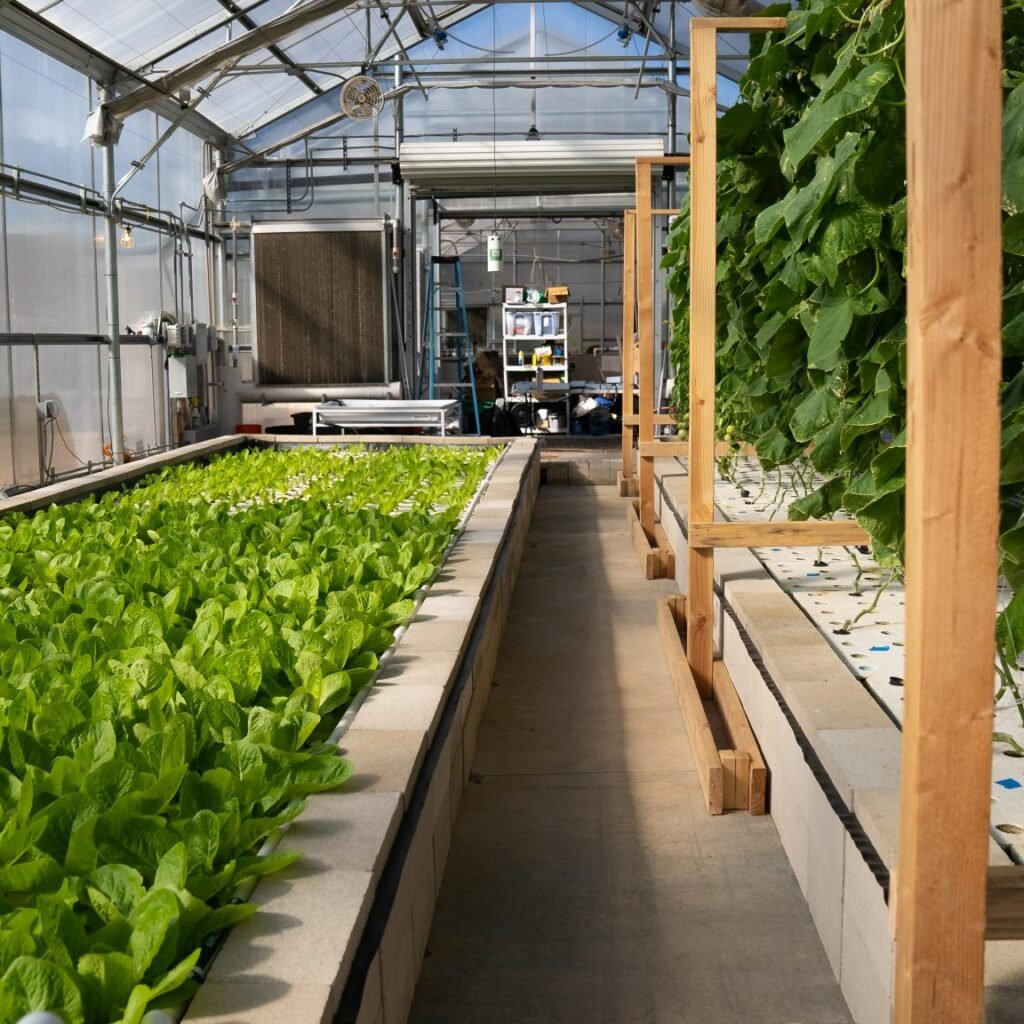
The combination of an aquarium and a greenhouse is known as aquaponics—a sustainable farming method that connects fish and plants in a closed, balanced ecosystem.
Here’s how it works:
- The fish produce waste (mainly ammonia), which is broken down by beneficial bacteria into nitrates.
- These nitrates become nutrients for plants growing in water beds or hydroponic channels above the aquarium.
- The plants filter and clean the water naturally, which is then recirculated back to the fish tank.
It’s a self-sustaining system—fish and plants support each other, and you save both water and fertilizer in the process.
Why Build a DIY Aquarium-Greenhouse System?
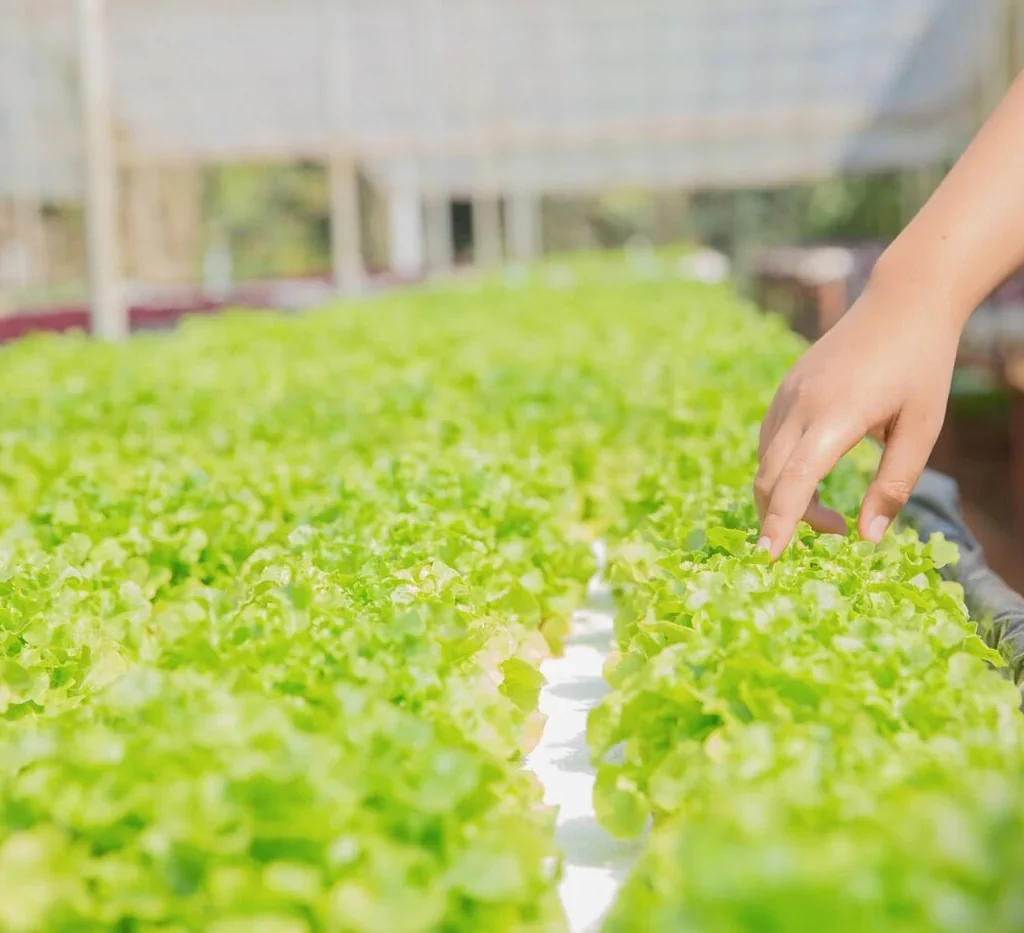
Building your own aquaponic system has several benefits. Whether you’re a home gardener, a farmer looking to diversify, or someone passionate about sustainable living, this setup offers major advantages:
- Year-Round Production:
The greenhouse protects plants from harsh weather, allowing for continuous growing regardless of season. - Zero Waste:
Fish waste feeds the plants, and the plants purify the water for the fish—creating a closed-loop cycle. - No Chemicals or Soil Needed:
Aquatic vegetables grow in water, not soil, so you avoid pests, weeds, and chemical fertilizers. - High Yield in Small Space:
Perfect for urban farming or backyard setups with limited space. - Low Maintenance:
Once established, the system needs only regular feeding for the fish and occasional cleaning.
What You’ll Need to Build a DIY Aquarium and Greenhouse System
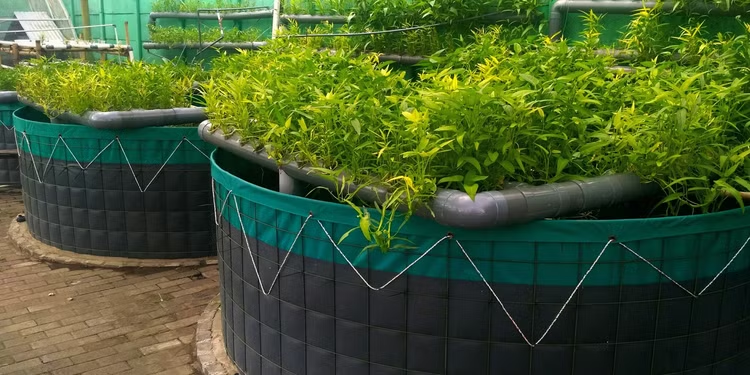
You don’t need expensive equipment to start your aquaponic garden. With some creativity and basic materials, you can build one using affordable or recycled components.
Here’s a list of essential materials:
- Aquarium or Fish Tank: Large enough to hold your desired fish population (100–200 liters is great for beginners).
- Greenhouse Frame or Cover: Can be made from PVC pipes, wood, or metal, and covered with clear plastic sheeting.
- Water Pump: To circulate water between the aquarium and the plant bed.
- Growing Bed or Trough: For planting aquatic vegetables (can be plastic containers, shallow tubs, or grow trays).
- Filter System: Simple mechanical or biofilter to remove solid waste.
- Aquaponic Media: Like clay pebbles, gravel, or sponge to support plant roots.
- Aquatic Plants or Seeds: Water spinach (kangkong), lettuce, basil, and mint are great starters.
- Fish: Tilapia, goldfish, or catfish work well—they’re hardy and adapt easily.
- PVC Pipes or Tubing: For water flow between the fish tank and grow bed.
- Air Pump: To oxygenate the water and keep fish healthy.
- pH Testing Kit: To ensure the water stays balanced for both fish and plants.
Step-by-Step: How to Build Your Aquarium-Greenhouse System
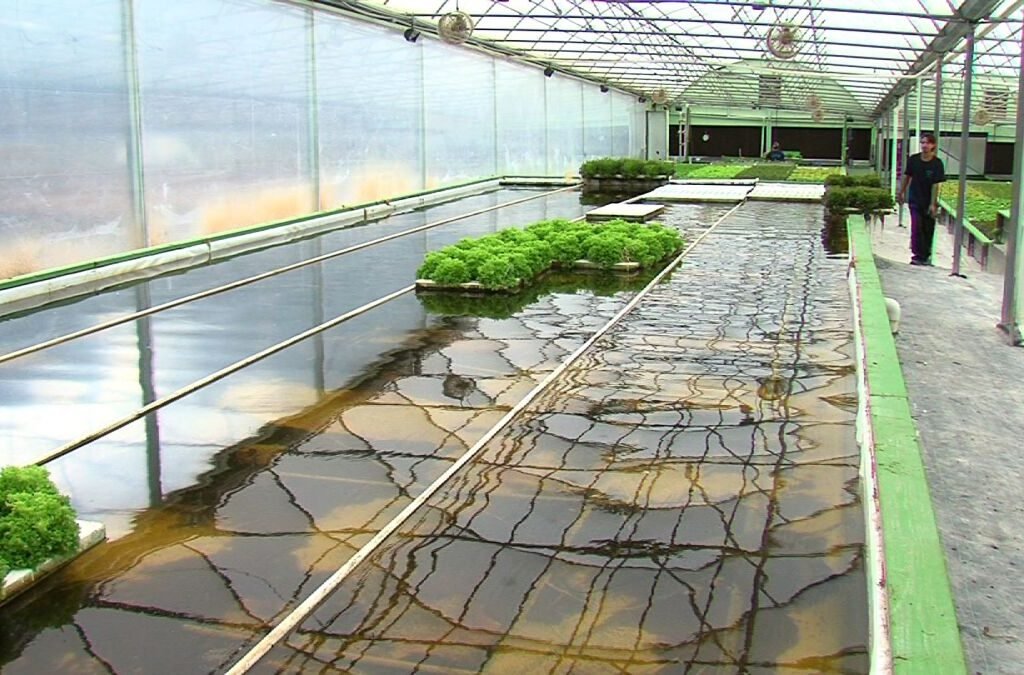
Let’s walk through how the farmer built his setup from scratch. This same process can be adapted for your backyard or balcony garden.
Step 1: Build the Greenhouse Structure
Start by constructing a simple greenhouse frame using lightweight PVC pipes or wood. Cover it with clear plastic sheets or polycarbonate panels to trap sunlight and protect your system from wind and rain.
Make sure the greenhouse allows enough airflow—you can install small vents or mesh windows to prevent overheating.
Step 2: Set Up the Aquarium or Fish Tank
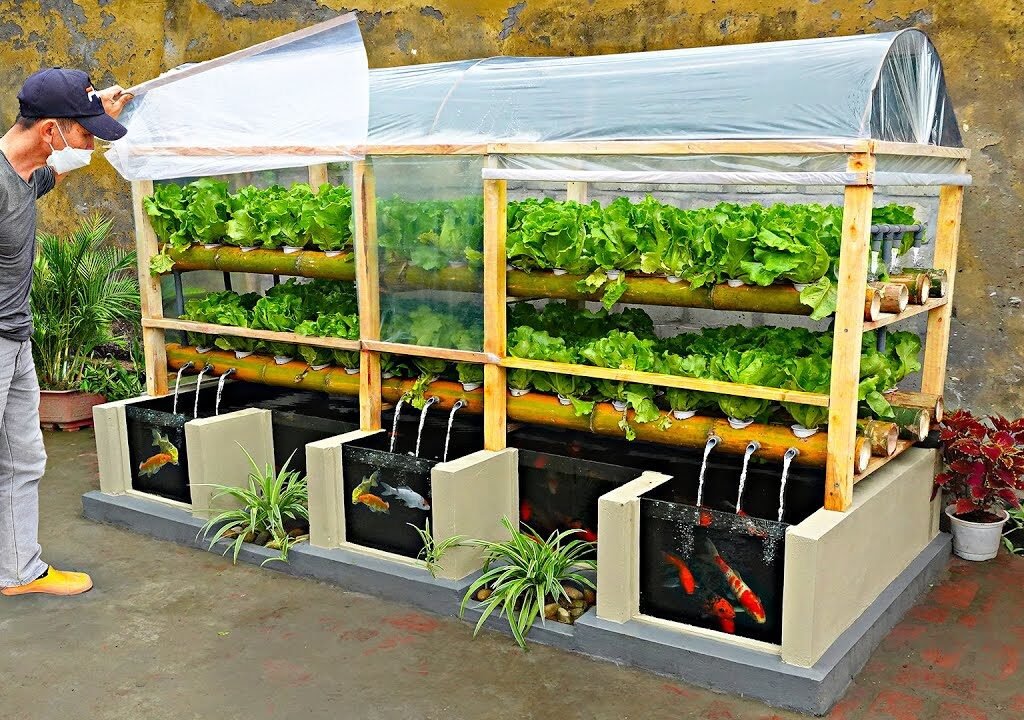
Choose a sturdy aquarium or tank and place it on a flat, stable surface inside the greenhouse. If possible, elevate the grow bed above the aquarium to allow gravity-fed water circulation.
Add dechlorinated water, then introduce your fish once the system stabilizes. Start with a few hardy species like tilapia or goldfish—they’re great for beginners and produce enough waste to feed your plants.
Step 3: Install the Water Pump and Pipes
The water pump will move nutrient-rich water from the fish tank to your grow bed.
- Connect PVC pipes or hoses to the pump’s outlet and lead it into your plant container.
- Drill small drainage holes in the plant bed so the water can flow back into the aquarium.
- Use gravity to your advantage—position the grow bed slightly higher than the fish tank.
This circulation ensures plants receive nutrients while maintaining clean, oxygenated water for the fish.
Step 4: Prepare the Grow Bed
Fill your grow bed or trough with a growing medium such as gravel, clay pellets, or sponge foam. This provides support for plant roots and acts as a biofilter, helping beneficial bacteria thrive.
Plant your aquatic vegetables directly into the bed, ensuring roots are submerged but not fully drowned. You can use seedlings for faster results.
Step 5: Introduce the Plants and Fish
Once your system is circulating water properly, add the fish to your aquarium and the plants to your grow bed.
Feed your fish regularly with commercial fish feed or natural food like worms and kitchen vegetable scraps. The waste they produce will break down into nutrients for your plants.
Monitor the water’s pH (6.5–7.0) and ammonia levels weekly to keep everything balanced.
Step 6: Maintain the System
The beauty of this system is that it requires very little upkeep:
- Feed the fish daily.
- Check the water pump and air pump weekly.
- Remove any dead leaves or plant debris.
- Test the water’s pH and temperature periodically.
- Add water to the tank to replace evaporation losses.
That’s it! The system takes care of itself, with fish and plants working in harmony.
What Aquatic Vegetables Can You Grow?
The farmer demonstrated that many aquatic or semi-aquatic plants thrive beautifully in this type of system. Some of the best choices include:
- Water Spinach (Kangkong): A fast-growing leafy vegetable that loves nutrient-rich water.
- Lettuce: Grows well in hydroponic-style aquaponic setups.
- Watercress: Perfect for wet environments and rich in vitamins.
- Mint and Basil: Thrive in moist media and absorb nutrients efficiently.
- Chinese Celery: Popular in Asian cuisine, grows easily in shallow water.
If you’re adventurous, you can even experiment with aquatic flowers like lotus or water lilies, although these are mostly ornamental.
Benefits of Combining Fish and Plants
This smart method offers benefits beyond just fresh vegetables. It’s an incredible example of natural symbiosis, where every element has a purpose:
- Fish waste → food for plants
- Plants → natural filter for fish water
- Microbes → convert ammonia into nutrients
This cycle reduces waste, saves water, and produces organic, pesticide-free food. It’s a sustainable system that works beautifully both at a small and large scale.
Tips for a Successful DIY Aquarium-Greenhouse Setup
- Start Small: Begin with a few fish and a small grow bed to learn the basics before expanding.
- Balance Is Key: Don’t overcrowd the fish tank. More fish means more waste, but too much can harm water quality.
- Ensure Proper Lighting: Aquatic vegetables need at least 6–8 hours of sunlight daily, or use LED grow lights indoors.
- Monitor Water Quality: Test ammonia, nitrate, and pH levels regularly.
- Harvest Gradually: Trim or harvest leaves regularly to encourage continuous growth.
Why This DIY System Is Perfect for the Future
With growing concerns about food security, water scarcity, and climate change, systems like this are becoming essential. They make it possible for families and small farmers to produce food sustainably, without relying on expensive fertilizers or large farmland.
The farmer’s creative use of a DIY aquarium and greenhouse proves that innovation and sustainability can go hand in hand. It’s a low-cost, high-reward method anyone can replicate at home—with a little effort and a lot of curiosity.
Final Thoughts
Building a DIY aquarium-greenhouse system to grow aquatic vegetables isn’t just an exciting project—it’s a step toward sustainable living. By learning from resourceful farmers, we can grow fresh, organic food while conserving water and energy.
Whether you’re a hobby gardener or a serious grower, this system offers endless possibilities. You can produce your own food, teach kids about ecosystems, and contribute to a greener planet—all from your backyard or balcony.
So why not start today? Gather your materials, follow these steps, and watch your aquatic garden flourish. You’ll be amazed at how fish, plants, and nature work together in perfect harmony.
SEO Keywords:
DIY aquarium greenhouse, grow aquatic vegetables, aquaponics system at home, sustainable farming, hydroponic vegetables, fish tank gardening, home aquaponic setup, grow water spinach, eco-friendly gardening, self-sustaining greenhouse.
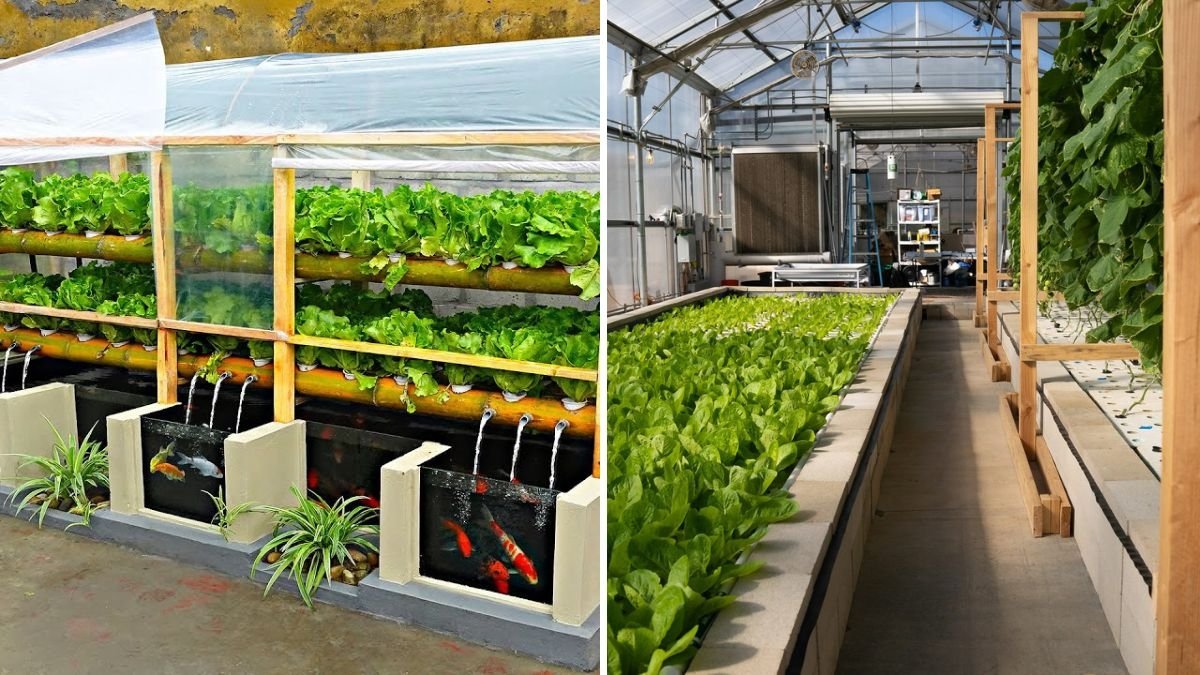




Leave A Comment